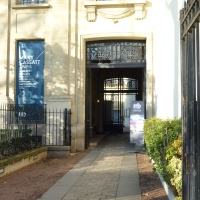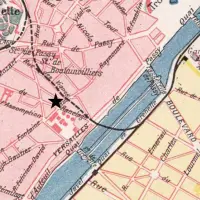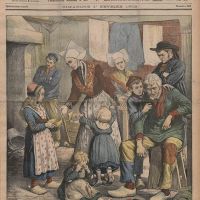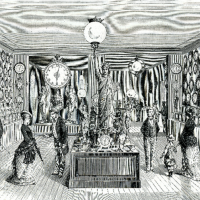So many sights in Paris pique our curiosity and lead us to learn things we would not have learned otherwise. This blog post began as we thought about the beauty of Paris’s zinc roofs. One could argue that zinc roofs say “Paris” every bit as much as the Eiffel Tower.
Once, when we were in Paris at Christmastime, we were delighted to see zinc roofs featured in the windows of the Bon Marché department store. The window designers clearly appreciated these very Parisian features.
This display caused many passersby to stop, look, and look again.
Zinc is a relative newcomer to Paris. As with so much of the material world, the metal was known and used for centuries in Europe, India, and China well before it was “scientifically” identified as an element in 1746 (working knowledge often precedes scientific understanding). Only in the early 1700s was zinc on the path to being readily purified and manufactured.
Pure zinc has a bluish-white colour; it is hard and brittle at most temperatures and unsuitable for roofing. However, its properties can be changed by mixing it with other metals, such as tin or titanium, to make a more flexible and workable alloy.
Zinc is a very reactive element. When exposed to air and moisture, it forms a surface that protects the entire exposed sheet. It is even self-healing; if the coating is scratched, the surface can reform so that protection continues.
Longevity is another of zinc’s attractions, although that may be changing somewhat. Parisian restoration architect Patrice Roy told us that “roofs used to be waterproof for a century and a half, but because of acid pollution [today], it takes less time for holes to form [in zinc].”
The soft colour of zinc and its subtle matte finish are other important properties. Paris has many overcast days and zinc roofs take on and reflect the colours of the sky.
The use of zinc for Paris roofs can be traced to the work of a cleric called Jean-Jacques Dony of Liège in the early 19th century (Liège was part of France then; today it is in Belgium). Many clerical positions left ample time to pursue other interests and Abbé Dony used his free time to study chemistry, in particular the smelting of zinc. In 1805, Napoleon Bonaparte granted Dony a permit to extract zinc from a mine in Moresnet, roughly 50 km east of Liège. The mine was known as Vieille Montagne.
Five years later, Dony obtained a patent for his method of processing and refining zinc, which was a modification of pre-existing processes rather than a completely new approach.
New technologies often require newsworthy demonstration projects and Abbé Dony hit upon the idea of showing his gratitude to Napoleon by giving him a zinc-lined bath. Napoleon was apparently so thrilled by its light weight and utility that he took it on his campaigns, including his ill-fated invasion of Russia. The bath lasted longer than Napoleon and can still be seen at the Maison de la Metallurgie et de l’Industrie in Liège.
Napoleon was not the only one whose luck ran out. By 1813 Dony was deeply in debt and had to sell his patent and mining rights. He died in poverty in 1819. However, the company grew and prospered to become the largest zinc-producing company in the world. It also led to a rather strange political outcome for Moresnet, where the mine was located. (We’ve included this story at the end of the blog.)
We do not know when or where zinc was first used for roofing and cladding, but the earliest high-profile projects included a zinc roof for the church of St-Barthélémy in Liège followed by one for the Cathedral of St. Paul in the same city.
At that time, most Paris roofs were made of slate, most of it brought from the Loire Valley. Napoleon III and Haussmann changed that in the mid-19th century with the renovation of Paris. New construction on such a massive scale called for faster and more economical roofing construction. Zinc sheets were lighter than slate, less expensive, and easier to install, and they protected buildings from water leakage. They could even be melted down and recycled when buildings were demolished.
In addition, zinc could be used to create curved shapes or sharply angled roofs – opening the way for more elaborate roof designs to suit the tastes of the 19th century and making possible the tiny top-floor apartments to which maids and domestic staff were relegated.
The illustration below is from an early 20th-century trade catalogue from the Société Anonyme des Mines et Fonderies de Zinc de la Vieille-Montagne shows the kinds of shapes that were possible (along with zinc finials and decorative touches). Zinc was also used for drainpipes and eavestroughs.
Roofing was made from a zinc alloy that had been rolled to a specific thickness and cut to size. The catalogue includes an image of the rolling mill with the rollers in the background and stacked sheets of cut zinc on wagons on the left.
However, the new material had to be used carefully and skilfully. It wasn’t a case of plunking it down and waiting for 100 or so years to see how it was faring.
An important feature of zinc roofs are the zinc-covered seams that join the sheets, creating the characteristic stripy look of the roofs. Another image from the trade catalogue shows a cross-section of these standing seams.
Figures 5 and 6 show pieces of zinc bent and butting against a piece of wood. Figures 7 and 8 show the cap that covers the joint to keep rain out. The photo below shows how this type of installation looks on a roof in Paris.
Proper installation is crucial. Each sheet has an unexposed side underneath and here is where things can go wrong and reduce the lifespan of the zinc sheets. This photo shows what that looks like.
As we learned from an online article about the challenges of using zinc, the exposed surface of zinc receives its protective patina through a three-step natural process. First, zinc exposed to oxygen in the air produces a thin layer of zinc oxide, which in the second step reacts with water to form zinc hydroxide. In the third step, the hydroxide reacts with carbon dioxide in the atmosphere to form a stable long-lasting surface patina of zinc hydroxyl carbonate. The reaction sequence is finished after this third step and the zinc is thereafter protected from the elements.
If the zinc is not properly installed, things can go wrong on the hidden underside. If there is water but no air, the reactions do not go to the third, stable phase. Instead, the unstable or reactive zinc oxide produces zinc hydroxide, which consumes zinc in the process. So long as there is water present, the process will continue to eat away at the back of the metal to produce what is called “white rust” and eventually it will eat through the zinc sheet. As we see in the photo above, the zinc simply flakes away.
In 2014, Paris began the process for recognizing zinc roofing on UNESCO’s list of Intangible Cultural Heritage. Why “intangible”? It is not the zinc roofs themselves that need protection, but the techniques and knowledge of the Parisian roofers who work year-round to create, maintain, and repair the roofs of Paris and those in other parts of France. Zinc workers are getting on in years and it is hard to find apprentices to continue the work and traditions.
Of course, roofs are not the only use of zinc to be seen in Paris. Traditionally, many bistros had zinc-covered bars, although these have mostly been replaced by stainless steel, since red wine reacts badly with zinc. This one had a label: Les étains de Lyon (Lyon stainless steel).
You can also see galvanized railings with their characteristic surface crystals. Galvanizing is a zinc coating created by dipping metal in a bath of molten zinc, withdrawing it and allowing it to cool. As it cools one can see the formation of zinc crystals of various sizes. The faster the cooling, the smaller the crystals.
Zinc can even be used in organ pipes – some of the recitals we have heard in Paris churches may have been made possible in part by the presence of zinc.
Early 2021 finds us all in the same storm – Covid-19 – although we are in different boats. While we cannot yet plan our next trip to Paris, Covid-19 has given us time to think about what Paris means to us, and we realize now that the soft grey, stripy roofs of the city are an important part of the city’s beauty.
Blog text and photographs by Norman Ball; image of “white rust” from Simpson Gumpertz & Heger, originally posted on BuldingEnclosureOnline.com; trade catalogue images from Bibliothèques specialisées Paris.
A little epilogue about Moresnet.
In this map of the province of Liège from the early 19th century, created during the short period in which this area was part of France, you will see Liège to the west, on the River Meuse, and Moresnet at the very far east, near the orange border. On the other side of the border was Limbourg, one of the patchwork of duchies, counties, and principalities that at the time occupied the area to the east.
Napoleon’s defeat at Waterloo in 1815 led to a grand re-drawing of the map of Europe. Liège became part of the Netherlands. And nearby Moresnet, with its productive zinc mine, found itself on the border between the Netherlands and the German Confederation, coveted by both countries.
The delegates at the Congress of Vienna seemingly couldn’t make up their collective minds and created a tiny territory called “Neutral Moresnet” surrounding the mine property, to be jointly administered by the Dutch and the Germans. (When Belgium was formed in 1830, the Belgians got to participate, too.) Yet the currency and the legal framework remained French: the franc and the Code Napoléon.
This map shows Neutral Moresnet. It was less than 2 km wide at its widest and less than 5 km from north to south, in all about 3.5 square km. At the time of its creation, the place was home to fewer than 300 people.
The population swelled to about 3,000 as the mine expanded. In 1837, the Société des Mines et Fonderies de Zinc de la Vieille-Montagne was formed; not only did it manage the mine, but it ran schools, a hospital, and company shops (just like the old one-company mining towns of Canada).
All went well until 1885, when the mine was exhausted (other mining towns have faced this dilemma, too). Various money-making schemes were tried. A separate postal service, issuing its own stamps (hey, it worked in San Marino!), was, ahem, stamped out by the Belgian and German authorities. A casino opened in 1903, but also did not meet with official approval. Several gin distilleries operated. There were public festivals to attract tourists. This image from Le Monde Illustré, 4 January 1908, shows the members of La Société de Carnaval de Moresnet. They look like jolly fellows.
But the most original idea, launched in 1908, was to make the little territory into the centre of the study and use of Esperanto, the proposed universal language invented in the 1880s. The territory was to be called Amikejo, that is, “place of friendship.” The residents studied the language, hoping to provide an example for others. But with the loss of the mine, the territory’s raison d’être had evaporated. The Germans occupied the little territory and at the end of the First World War, with the Treaty of Versailles, it became part of Belgium.
Text by Philippa Campsie, maps and newspaper image from Gallica.






































Terrific article. Thank you for always finding more about Paris. I love the roofs/rooves too.
Glad you like them too. When will we be able to get back to see more? Thanks for your comment.
In Paris, most of the time, zinc roofs match the light-grey colour of the sky.
Thank you for your help in understanding zinc roofs. You might like to look at the trade catalogue listed at the end of my piece.
Many thanks for another wonderfully informative and illustrated article. Zinc is still a popular roofing material, and you can now obtain it in different patinas and colours: https://www.vmzinc.co.uk/zinc-basics/surface-appearances.html. Environmentally reasonably sustainable too in that it can be recycled, but there are the obvious issues over mining the material. Your country has done work on this: https://chemicalwatch.com/79438/zinc-is-harmful-to-the-environment-draft-canadian-assessment-concludes.
Thank you for your knowledgable comments and the links which I will be following up.
Absolutely fascinating! In a past life, not in France, my job involved getting up on zinc roofs occasionally. I loved it, and consequently knew some of the technical stuff you relate about them. But there is so much more in your post that I didn’t know!
Thank you very much. I admire you for getting up on zinc roofs. As a university student I had a summer job that required working at some height but I am a bit uncomfortable with heights. The views were great but not the feelings in my stomach. As my father, who was a very kind and understanding man and a construction superintendent, once said “you can walk across 6 inches on the ground. So what is differnce up in the air?” You visit them and I will write about them. Deal?
I am in awe of how much you uncover without being in Paris at the moment. This was an excellent post–in the research and information and in the style of writing.
I’m in the south of France and I cannot imagine the heat that a zinc roof would produce in summer, although we do have some Haussmannian buildings with curvy cupolas. The roofs around here are red tiles of terre cuite. They’re simply laid down in an overlapping manner, and every now and then have to be hiked back up because they slide a bit, a process called remaniement.
Thank you for your kind comments. I have a confession: I love the look of red tiles. I once thought about having them put on our house in Toronto until I found out the weight would have collapsed our roof. Ah well. we all have our dreams.
I love them, too. They do require beams that are practically tree trunks.
Yes, they do have some weight but less than tile roofs. Thank you for reading and commenting.
Absolutely fascinating. Thank you for all the effort that goes into researching and presenting the material. I have always enjoyed the look of the roofs of Paris, and now, thanks to you, I shall have knowledge to accompany the enjoyment.
What a delightful surprise to wake up to your post on a dreary, cold ,Toronto locked down morning. I will never take the roofs for granted again. I will now put on some café music, buy a croissant and dream of future visits. Thank you so much.
And if were not for all these Covid-19 restrictions I would have asked you to buy extra croissants and invite Philippa and Norman so we could eat and dream together. So glad you enjoyed the blog; it was fun to research, reminisce and write.
Really loved this fascinating background into the Parisian use of zinc. Thank you for all of your research and writing from a. very frosty and snowy Scotland!
Now isn’t that a trick? Here I am in Toronto where stereotypes would have us living under snow all winter and you are in Scotland not famous for snow. Or is it? Delighted that zinc helped blot out the snow. Enjoy the winter and I am sure I will put my snow shovel will to good use soon. It is a beauty, ergonomic and all that and no longer made. The new models look good but just aren’t as comfortable to use. So you want beauty and performance too? Really Dr. Ball, that is a bit much.
so interesting! Thank you!
Olive
And thank you too. With winter and Covid-19 we need all the help we can get.
Dear Norman and Philippa,
I have just spent a VERY enjoyable half hour reading this most recent Parisian Fields blog, and jumping back, via the link, to Philippa’s blog – “Maids and Domestic Staff”, which I somehow managed to miss before! I loved reading both.
I wish my Paris experience had been a little more like yours! I spent a few days there in 1981 with a camp friend. I am sorry to say I didn’t like her very much. Our difficult relationship coloured my experience in that beautiful city. John and I spent a very short time in Paris in May 1983, but the main focus of that trip (our belated honeymoon!) was a month in the Loire Valley where we lived in a house built into the hill – a troglodyte!
I hope you are both well and coping with this latest lockdown. I continue to go for long walks with Eyquem every morning, often with neighbour friends, and lately I’ve been cross country skiing once a week up at Kawartha Nordic (about 40 minutes north of here). John’s knees and back aren’t up to the longer ski days, but we’ve had some lovely swooshes up the river. Since the beginning of the lockdown, I’ve been going to mum’s every day to help her out. The hours and days and weeks seem to meld into one another, don’t they?
Love Nicola
Dear camper and friend of troglodytes, me thinkest it be time to revisit Paris once the resrtictions be lifted. Tarry not. waste no time for the very beauty of your smile and kind disposition are at great risk. When Paris beckons thou shouldst go there and even when it does not, just go there. Trust me, I am not a real doctor. Many thanks for your kind comments but look now to thy health and future happiness. Dream of Paris. Skiing too is good but only as prepartion for zinc and absence of snow.
Fascinating post! Those roofs are beautiful and I never fully recognized them before.
Thanks for your kind comments. You like us and we like your restauranting through history. It is always fun and informative and often a subject of conversation here. Let’s all of us carry on writing and posting.
Nice post thanks for sharing.